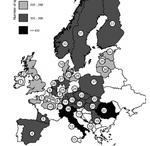Abstract
1. Relationships between species richness in higher taxa and large-scale environmental variables have been widely studied over the past 15 years. Much less is known about how different functional groups (FGs) of species with similar biological and life-history traits contribute to the overall trends, or how they differ in species-richness patterns.
2. Multivariate analysis clustered 641 species of Syrphidae into eight FGs on the basis of 10 life-history features, revealing feeding strategy as the main factor separating the groups.
3. Geographical trends in species richness and determinants of species richness within the FGs were compared across Europe.
4. Total species richness showed no latitudinal trend. However, the richness of individual FGs revealed variable relationships with latitude, including positive, negative, and hump-shaped ones. This appeared to be related to how different environmental factors affected species richness within FGs.
5. Functional groups differed in their responses to the environmental variables. Annual temperature, evapotranspiration, and elevation span were the most important variables separating the FGs in ordination analysis. The multiple regression models showed further differences between FGs and their responses to the environment.
6. The FG approach revealed important inconsistencies in latitudinal diversity gradients and diversity-climate relationships.
